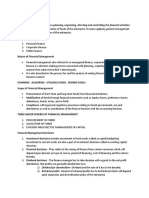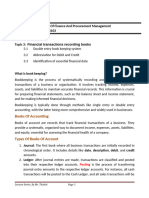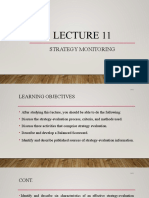Topic 1
Uploaded by
thabiti mohamediTopic 1
Uploaded by
thabiti mohamediCourse Title: Introduction to Financial Management
Course Code: DFM 06102
Topic 1: The Finance Function
1.1 Definitions, Central Goal of Finance and Objective of the firm
1.2 Role of financial manager
1.3 Business and the Financial system
WHAT IS FINANCE?
Finance is defined by Webster's Dictionary as “the system that includes the circulation of money, the
granting of credit, the making of investments, and the provision of banking facilities.” Finance has
many facets, which makes it difficult to provide one concise definition.
OR
Finance may be defined as the provision of money at the time it is required.
OR
Finance is the management of money, including the processes of investing, borrowing, lending,
budgeting, saving, and forecasting. It is concerned with how individuals, companies, and
governments handle their financial resources.
Main Types of Finance
A. Personal Finance: Managing your own or your family’s financial situation, including
budgeting, saving, and investing.
Key elements:
Income: Money you earn (salary, investments, etc.).
Expenses: Money you spend on necessities and other things.
Savings: The portion of income you keep aside for future needs or emergencies.
Investments: Putting money into assets like stocks, bonds, or real estate to grow your
wealth and generate a return.
FINANCE SERIES, BY MR THABITI Page 1
B. Corporate Finance: How businesses manage their finances.
Key elements:
Raising Capital: How businesses get money to fund their operations (e.g., selling shares or
borrowing).
Financial Planning: Making sure there is enough money to meet business goals.
Risk Management: How businesses protect themselves against financial loss.
C. Public Finance: How governments manage money. Key areas include taxation, government
spending, and national budgets.
Financial management: Financial management is the process of planning and controlling of the
financial resources of a firm. It includes the acquisition, allocation and management of firms’
financial resources.
Key Financial Concepts:
Time Value of Money (TVM): A dollar today is worth more than a dollar in the future due to
its potential earning capacity. TVM is used in calculating things like interest and investment
returns.
Interest: The cost of borrowing money or the return you earn from lending it.
Simple Interest: Interest calculated on the principal amount only.
Compound Interest: Interest calculated on both the principal and any interest already
earned.
Risk and Return: Every investment carries a level of risk. Generally, higher risks are
associated with higher potential returns, but there is also a greater chance of loss.
Liquidity: How easily an asset can be converted into cash without losing value. Cash is highly
liquid, while real estate is less liquid.
Diversification: Reducing risk by spreading investments across different assets or sectors.
“Don’t put all your eggs in one basket.”
Central Goal of Finance and Objective of the Firm
The central goal of finance is to maximize the wealth of the firm’s shareholders, which is often
interpreted as maximizing the company’s stock price.
FINANCE SERIES, BY MR THABITI Page 2
This objective aligns with the interests of stakeholders, including employees, customers, and
suppliers, as a financially healthy firm can provide better job security, quality products, and reliable
services. The financial manager plays a crucial role in achieving this goal by making informed
decisions regarding investments, financing, and dividends.
To achieve this objective, firms must focus on several key areas:
Investment Decisions: Identifying profitable projects that will yield returns greater than
their costs.
Financing Decisions: Determining the optimal capital structure that minimizes costs while
maximizing value.
Dividend Decisions: Establishing policies for returning profits to shareholders while
retaining enough earnings for growth.
Overall, the objective of the firm extends beyond mere profit maximization; it encompasses
sustainable growth and responsible management of resources.
The Financial Manager
A financial manager is a professional individual who is responsible for overseeing and managing the
activities of an organization. A financial manager may hold various titles, such as chief financial
officer (CFO), Treasure, or controller depending on organization’s structure and their specific
responsibility.
Roles of Financial Manager
The financial manager serves as a pivotal figure in guiding a firm’s financial strategy and operations.
Their primary responsibilities include:
1. Financial Planning: Developing long-term strategies to ensure that the firm has sufficient
funds to meet its operational needs and investment opportunities.
2. Budgeting: Creating budgets that align with strategic goals and monitoring performance
against these budgets.
3. Risk Management: Identifying potential risks such as market risk, operational risk, and credit
risk to the firm’s financial health and implementing strategies to mitigate these risks such as
hedging and diversification.
4. Capital Management: Overseeing capital expenditures and ensuring efficient use of resources.
Also deciding the mix of debt and equity by considering the risk of each part and benefits.
5. Reporting: Providing accurate financial reports to stakeholders that reflect the firm’s
performance and position.
6. Working capital management. A financial manager must also manage the day to day
operations of the firm, including managing cash flow, inventory, and receivables to ensure
liquidity and operational efficiency.
FINANCE SERIES, BY MR THABITI Page 3
7. Investment decision. The financial manager is the one who responsible for evaluating
potential investment projects that the firm allocates capital in a way that maximizes
shareholders wealth.
Business & Financial System
Financial system: Is a network of institutions, markets, instruments, and regulations that facilitate
the flow of funds between savers, investors, and borrowers.
Is a network that enables the exchange of funds between individuals, businesses, and governments.
It plays a crucial role in the functioning of the economy by facilitating the flow of money and credit,
supporting economic growth, and helping manage risks. The system is composed of various
institutions, instruments, and markets, all interconnected to efficiently allocate resources and ensure
the economy's stability.
Key Components of the Financial System
1. Financial Institutions: These include entities like banks, credit unions, insurance companies,
pension funds, and investment firms. Their primary role is to act as intermediaries between savers
(those with excess funds) and borrowers (those needing funds). Key functions include:
Commercial Banks: Accept deposits, offer loans, and provide various financial services like
payment processing.
Investment Banks: Specialize in large and complex financial transactions such as
underwriting new debt and equity securities, facilitating mergers and acquisitions, and
offering advisory services.
Insurance Companies: Provide risk management by collecting premiums and paying out
claims for life, health, and property insurance.
Pension Funds: Invest contributions made by employees and employers for future
retirement benefits.
2. Financial Markets: These are platforms where financial instruments like stocks, bonds, currencies,
and derivatives are traded. They facilitate price discovery, liquidity, and efficient allocation of capital.
Stock Market: A place where shares of publicly traded companies are bought and sold. It
enables businesses to raise capital by issuing equity.
Bond Market: A platform where debt instruments (bonds) are traded. Governments and
corporations issue bonds to raise capital by borrowing from investors.
Money Market: Deals with short-term debt instruments like Treasury bills and commercial
paper, which have maturities of less than one year.
Foreign Exchange Market (Forex): Where currencies are exchanged, helping international
trade and investment.
FINANCE SERIES, BY MR THABITI Page 4
3. Financial Instruments: These are the products or contracts that are traded in financial markets.
They can be divided into two broad categories:
I. Debt Instruments: Examples include loans and bonds, where borrowers agree to repay the
lender with interest over a specified period.
II. Equity Instruments: Financial securities that represent ownership in a company, such as
stocks or shares. Stocks represent ownership in a company and entitle shareholders to a
portion of its profits.
III. Derivatives: Contracts whose value is derived from the performance or value of underlying
assets, like stocks or bonds. Common derivatives include options, futures, and swaps, which
help manage risks (e.g., hedging against price fluctuations).
4. Financial Regulators: These are government agencies responsible for overseeing and ensuring the
stability and fairness of financial markets and institutions. Key regulators include:
Central Banks: Control the nation’s money supply and interest rates, as well as regulate
banks. Examples include the Federal Reserve in the U.S. and the European Central Bank and
in The bank of Tanzania here in Tanzania
Securities and Exchange Commission (SEC): In the U.S., the SEC oversees the securities
markets and protects investors by enforcing rules on transparency and integrity; here in
Tanzania we have DSE.
Financial Conduct Authority (FCA) in the UK: Ensures that financial markets work well and
that consumers are protected.
What are the functions of financial system?
1. Mobilizing Savings: The financial system channels savings from individuals, businesses, and
governments into productive investments. This is critical for capital formation and economic
growth.
2. Facilitating Payments: Financial systems make it possible for individuals and businesses to
exchange goods and services efficiently through payment systems (e.g., electronic transfers,
credit cards, and checks).
3. Creating and Distributing Risk: Through instruments like insurance policies, derivatives,
and diversification (e.g., mutual funds), the financial system helps distribute and mitigate risk.
It allows individuals and businesses to manage uncertainty and exposure to potential losses.
4. Providing Liquidity: Liquidity refers to the ease with which an asset can be converted into
cash. The financial system provides mechanisms (e.g., stock and bond markets) that allow
investors to buy and sell assets quickly, ensuring a smooth flow of funds across the economy.
5. Facilitating Price Discovery: In markets where financial instruments are traded, the
financial system helps determine the prices of these instruments based on supply and
demand dynamics. This ensures that resources are allocated efficiently.
FINANCE SERIES, BY MR THABITI Page 5
6. Ensuring Efficient Capital Allocation: By connecting savers with borrowers, the financial
system ensures that capital flows to its most productive uses. Businesses with profitable
investment opportunities can access the funds they need, which boosts overall economic
productivity.
FINANCE SERIES, BY MR THABITI Page 6
The connectivity of business with financial
system
The relationship between the business and the financial system is deeply intertwined, as businesses
rely on the financial system for capital, risk management, and operational efficiency, while the
financial system depends on businesses as key participants in financial markets and as borrowers.
Here’s a detailed breakdown of their interdependent
relationship:
1. Capital Raising
Businesses need capital to fund their operations, growth, and expansion. The financial system
provides a variety of mechanisms for businesses to access these funds:
o Debt Financing (Loans and Bonds): Businesses borrow money from banks or issue bonds in
financial markets to finance new projects, invest in infrastructure, or manage operational
costs. Banks, as part of the financial system, assess the creditworthiness of businesses and
lend money accordingly.
o Equity Financing (Stocks): Businesses can raise funds by issuing shares in the stock market.
By selling ownership stakes (equity), businesses can obtain the necessary capital for
expansion or innovation without taking on debt.
2. Liquidity and Cash Flow Management
Businesses need liquidity to meet their day-to-day operations, such as paying employees, purchasing
raw materials, and servicing debts. The financial system helps with liquidity in several ways:
Short-term Credit (Money Market Instruments): Businesses often use short-term debt
instruments like commercial paper, issued through money markets, to manage their working
capital needs. This allows them to cover short-term cash shortages efficiently.
Bank Loans and Overdrafts: Banks, as financial intermediaries, provide loans or overdraft
facilities that allow businesses to maintain a steady flow of cash even when they are awaiting
payments from customers or need to meet immediate obligations.
3. Risk Management
Businesses face various risks, including interest rate fluctuations, currency exchange rate volatility,
commodity price changes, and potential losses due to unforeseen events. The financial system helps
businesses manage these risks:
FINANCE SERIES, BY MR THABITI Page 7
Hedging with Derivatives: Financial derivatives such as futures, options, and swaps are traded
in financial markets and help businesses hedge against risks. For instance, a business that
imports raw materials can use currency futures to protect itself from exchange rate
fluctuations, while commodity futures help manage price risks in raw materials.
Insurance: Financial institutions, such as insurance companies, provide businesses with
policies that protect them from specific risks like property damage, liability, or business
interruption.
4. Payment Systems
Businesses need efficient payment mechanisms to conduct transactions with customers, suppliers,
and employees. The financial system provides these services:
Payment Processing: Banks and financial institutions offer services like wire transfers,
payment gateways, credit and debit card processing, and electronic fund transfers.
Foreign Exchange (Forex): Businesses that operate internationally rely on foreign exchange
markets to facilitate cross-border transactions. Forex markets allow businesses to exchange
currencies and manage the risks associated with currency fluctuations.
5. Business Investment Opportunities
The financial system provides businesses with opportunities to invest their surplus funds:
Investment in Securities: Businesses can invest surplus cash in financial instruments like
government bonds, stocks, or money market funds, allowing them to earn returns while
ensuring liquidity.
6. Economic Growth and Stability
The financial system supports economic growth by channeling capital into productive investments.
This, in turn, fosters business growth, employment, and innovation
7. Corporate Governance and Transparency
Publicly traded businesses are subject to financial market regulations that enforce transparency,
corporate governance, and investor protection. The financial system, through regulators like the
Securities and Exchange Commission (SEC) or Financial Conduct Authority (FCA), ensures:
Corporate Accountability: Businesses must disclose their financial performance, adhere to
governance standards, and provide regular reports to shareholders. This transparency builds
trust among investors and enhances the business’s reputation in financial markets.
Market Discipline: Financial markets reward businesses that perform well and punish those
that mismanage resources or fail to meet financial targets. This creates incentives for
businesses to operate efficiently and focus on sustainable growth.
FINANCE SERIES, BY MR THABITI Page 8
End of Chapter Questions:
1. Define Financial Management. Briefly describe functions of Financial
Management.
2. Describe the role of a finance manager.
3. Wealth maximization is the real objective of Financial Management as it helps in
financial decisions. Explain this statement.
4. Explain the relationships which exist between business and financial system.
FINANCE SERIES, BY MR THABITI Page 9
You might also like
- Explain The Objectives of Financial Management, Interphase Between Finance and Other FunctionsNo ratings yetExplain The Objectives of Financial Management, Interphase Between Finance and Other Functions12 pages
- Security Analysis and Portfolio ManagementNo ratings yetSecurity Analysis and Portfolio Management40 pages
- The First Time You Have A Problem Is If You're GoingNo ratings yetThe First Time You Have A Problem Is If You're Going51 pages
- The Financial Environment: © 2008 John Wiley and SonsNo ratings yetThe Financial Environment: © 2008 John Wiley and Sons39 pages
- Tactical Objective: Strategic Maneuvers, Decoding the Art of Military PrecisionFrom EverandTactical Objective: Strategic Maneuvers, Decoding the Art of Military PrecisionNo ratings yet
- Natinal Aviation College: Financial Management Finalexamination Name Solomon Abera Id Gblr/049/12 Section RegularNo ratings yetNatinal Aviation College: Financial Management Finalexamination Name Solomon Abera Id Gblr/049/12 Section Regular18 pages
- Unit-1 Introduction to Financial ManagementNo ratings yetUnit-1 Introduction to Financial Management132 pages
- Prepared by Dr.T.Hymavathi Kumari, Associate Professor: Advanced Financial Management Mbag Course Code 516No ratings yetPrepared by Dr.T.Hymavathi Kumari, Associate Professor: Advanced Financial Management Mbag Course Code 51624 pages
- Financial Management Module I: Introduction: Finance and Related DisciplinesNo ratings yetFinancial Management Module I: Introduction: Finance and Related Disciplines4 pages
- Introduction-to-finanace-09122024-014803pmNo ratings yetIntroduction-to-finanace-09122024-014803pm31 pages
- FINANCE Week 1 - Introduction To Business FinanceNo ratings yetFINANCE Week 1 - Introduction To Business Finance11 pages
- Unit 1 - Corporate Finance and Financial EnvironmentNo ratings yetUnit 1 - Corporate Finance and Financial Environment29 pages
- TOPIC 1 - Objectives and Scope of Financial ManagementNo ratings yetTOPIC 1 - Objectives and Scope of Financial Management48 pages
- Unit I - Overview of Finance and Financial Management: Notes 1 For Afm 101No ratings yetUnit I - Overview of Finance and Financial Management: Notes 1 For Afm 1015 pages
- Income Statement and The Statement of Cash FlowsNo ratings yetIncome Statement and The Statement of Cash Flows53 pages
- A New Star Is Born - Does The VIX1D Render Common Volatility Forecasting Models For The U.S. Equity Market ObsoleteNo ratings yetA New Star Is Born - Does The VIX1D Render Common Volatility Forecasting Models For The U.S. Equity Market Obsolete33 pages
- Using Volume To Make Better Trades - Traders LogNo ratings yetUsing Volume To Make Better Trades - Traders Log9 pages
- Case Study On Marketing Strategy of Sony CorporationNo ratings yetCase Study On Marketing Strategy of Sony Corporation3 pages
- Chap 13 - Intr To Exchange Rates and FX MarketNo ratings yetChap 13 - Intr To Exchange Rates and FX Market20 pages
- From Its Financial Statements (Marks 03) EBIT Rs 50,000/-Return of Equity 12% Amount of Equity Rs 100,000/ - Tax Rate 35%No ratings yetFrom Its Financial Statements (Marks 03) EBIT Rs 50,000/-Return of Equity 12% Amount of Equity Rs 100,000/ - Tax Rate 35%13 pages
- Looking For A Winning Strategy Amid Inflation - BlackRockNo ratings yetLooking For A Winning Strategy Amid Inflation - BlackRock4 pages
- Explain The Objectives of Financial Management, Interphase Between Finance and Other FunctionsExplain The Objectives of Financial Management, Interphase Between Finance and Other Functions
- The First Time You Have A Problem Is If You're GoingThe First Time You Have A Problem Is If You're Going
- The Financial Environment: © 2008 John Wiley and SonsThe Financial Environment: © 2008 John Wiley and Sons
- Tactical Objective: Strategic Maneuvers, Decoding the Art of Military PrecisionFrom EverandTactical Objective: Strategic Maneuvers, Decoding the Art of Military Precision
- Natinal Aviation College: Financial Management Finalexamination Name Solomon Abera Id Gblr/049/12 Section RegularNatinal Aviation College: Financial Management Finalexamination Name Solomon Abera Id Gblr/049/12 Section Regular
- Prepared by Dr.T.Hymavathi Kumari, Associate Professor: Advanced Financial Management Mbag Course Code 516Prepared by Dr.T.Hymavathi Kumari, Associate Professor: Advanced Financial Management Mbag Course Code 516
- Financial Management Module I: Introduction: Finance and Related DisciplinesFinancial Management Module I: Introduction: Finance and Related Disciplines
- Unit 1 - Corporate Finance and Financial EnvironmentUnit 1 - Corporate Finance and Financial Environment
- TOPIC 1 - Objectives and Scope of Financial ManagementTOPIC 1 - Objectives and Scope of Financial Management
- Unit I - Overview of Finance and Financial Management: Notes 1 For Afm 101Unit I - Overview of Finance and Financial Management: Notes 1 For Afm 101
- A New Star Is Born - Does The VIX1D Render Common Volatility Forecasting Models For The U.S. Equity Market ObsoleteA New Star Is Born - Does The VIX1D Render Common Volatility Forecasting Models For The U.S. Equity Market Obsolete
- Case Study On Marketing Strategy of Sony CorporationCase Study On Marketing Strategy of Sony Corporation
- From Its Financial Statements (Marks 03) EBIT Rs 50,000/-Return of Equity 12% Amount of Equity Rs 100,000/ - Tax Rate 35%From Its Financial Statements (Marks 03) EBIT Rs 50,000/-Return of Equity 12% Amount of Equity Rs 100,000/ - Tax Rate 35%
- Looking For A Winning Strategy Amid Inflation - BlackRockLooking For A Winning Strategy Amid Inflation - BlackRock








































































































